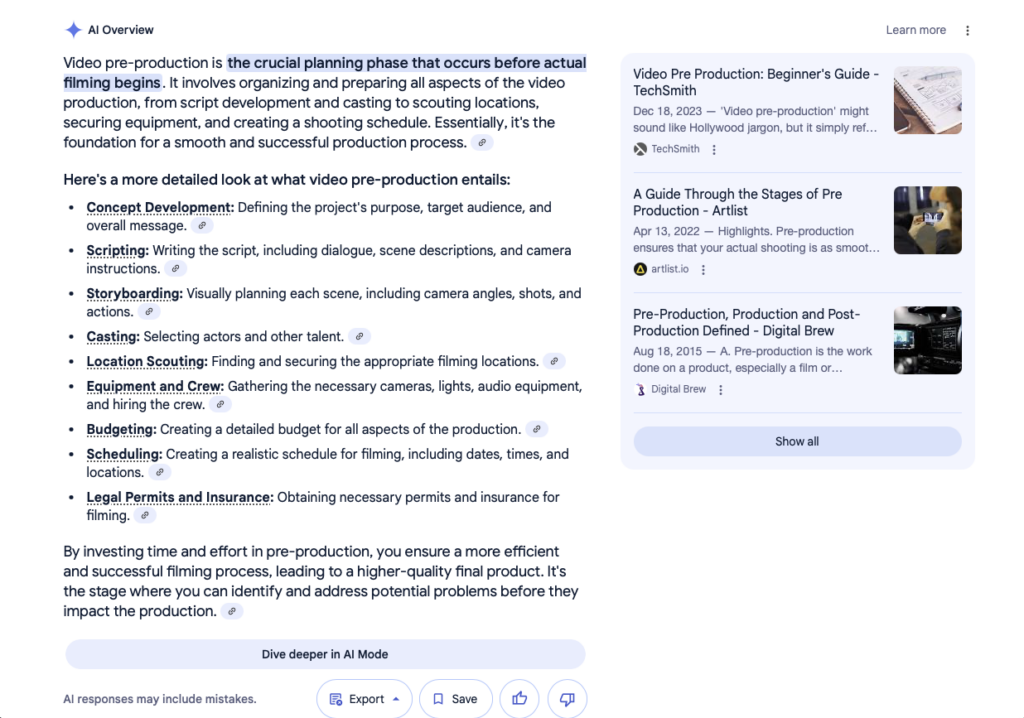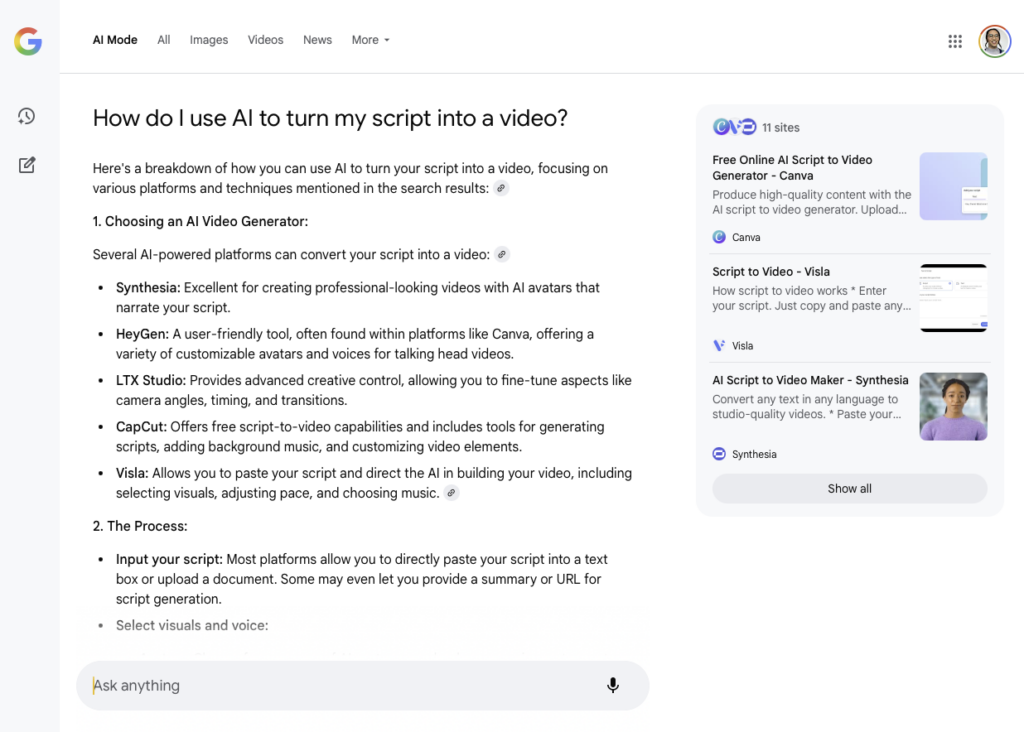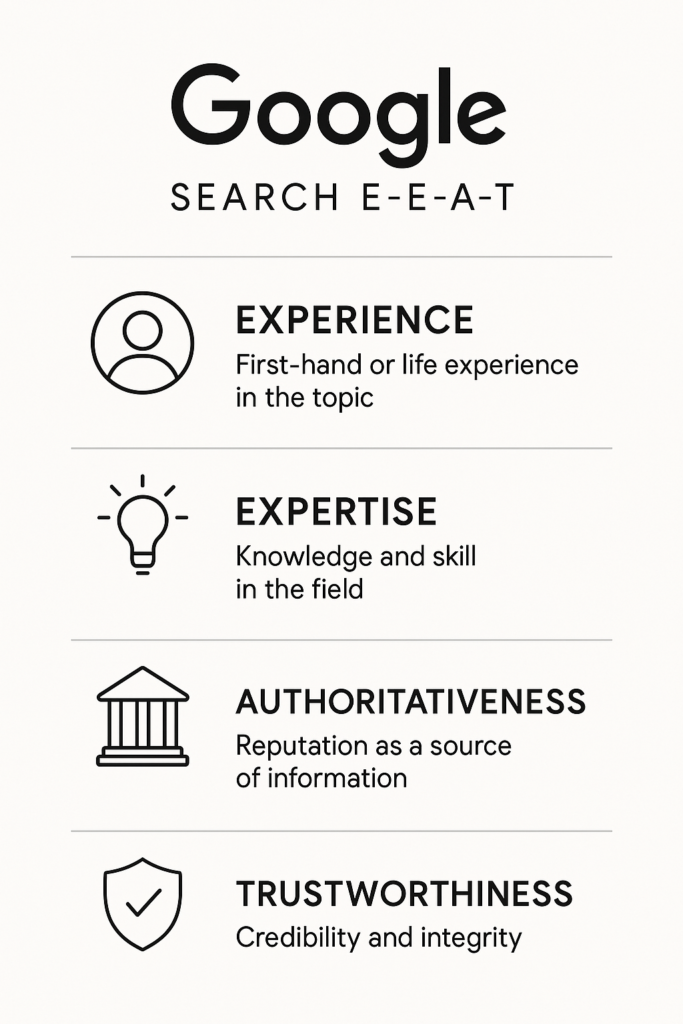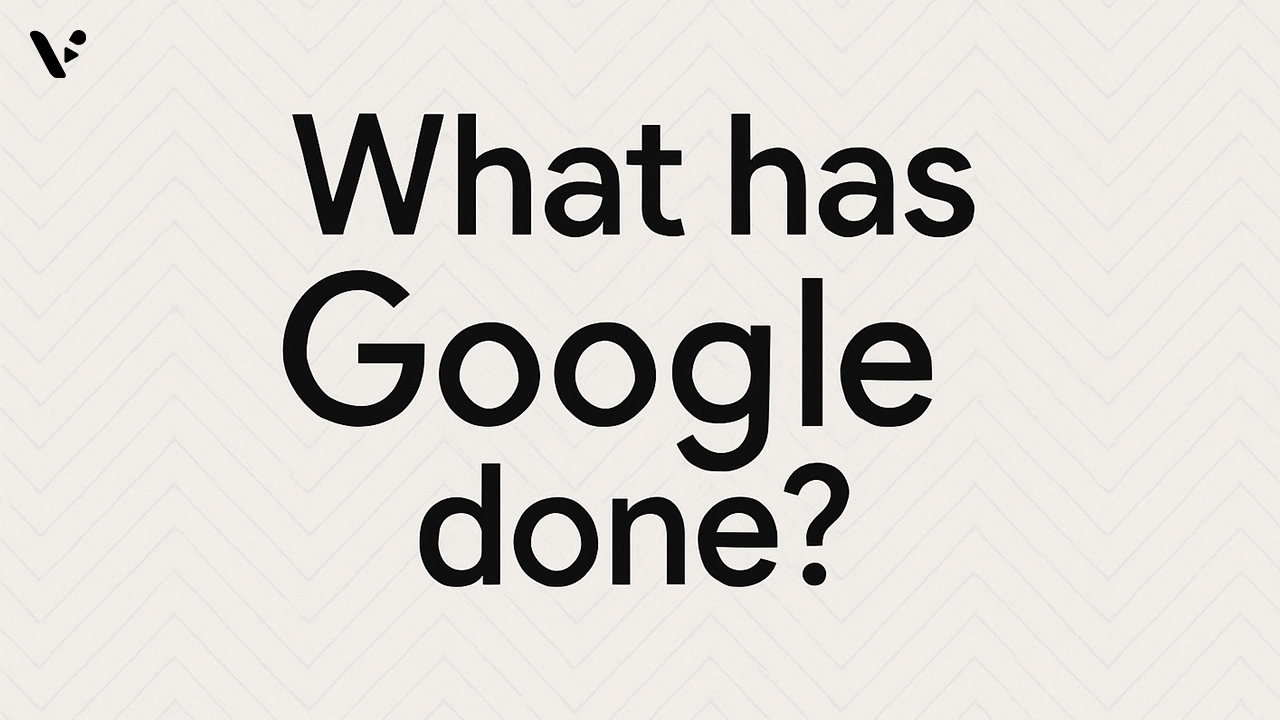Google’s new AI Mode officially rolled out in May 2025. But if you’ve been paying attention, this has been coming for a while. Remember AI Overviews? They launched last year to a chorus of jokes and screenshots: recommending glue on pizza, citing Reddit threads as medical advice. But here’s the thing. It HAS been getting better.
The AI Mode update doesn’t just add another feature. It changes the game for anyone even tangentially involved with SEO. And if you’re a content creator, SEO strategist, or anyone who wants their work to show up in search, you need to understand what’s shifting and how to respond.
Let’s break down what’s happening, what’s not, and what actually matters if you want to thrive in this new AI-driven search world.
What is Google AI Mode (and why should you care)?
Let’s get clear on what we’re talking about. AI Overviews are the little summary boxes Google now shows at the top of search results. They use a form of Retrieval-Augmented Generation (RAG) to stitch together answers from multiple web pages. It’s like a built-in chatbot answering your question, using your content to do it.

According to Google, AI Overviews now show up in over 13% of all search queries, and in some categories like entertainment, that number goes as high as 76%. They’re not going away. Instead, they’re becoming the default for many types of searches.
AI Mode, on the other hand, is more ambitious. It’s a full reimagining of how search works. Instead of showing you ten blue links, it uses Gemini to understand your question, run multiple sub-queries, pull from tons of sources, and generate a full, coherent response. It’s like a full-on assistant embedded in search.

So what does this mean for you?
It means the days of winning search with keyword-stuffed, semi-coherent articles are numbered. If Google’s using AI to understand and evaluate content, the content itself needs to be better.
No, AI content isn’t doomed
First things first: AI-generated content isn’t being buried by default.
Recent research shows that around 19% of all Google search results include content created with AI tools. That’s up from about 11% just a year ago. AI isn’t being excluded from search. It’s everywhere. And in April 2025, 74.2% of newly published web content included some form of AI generation.
But here’s the important bit: not much of top-ranking search results are purely AI-generated. When researchers analyzed the top 100 search results in a range of categories, the vast majority (~83%) were still written by humans.
In other words, AI can help you get there, but it probably won’t take you all the way.
But Lazy AI Content? Don’t Bother
You can’t just prompt ChatGPT with “write me a blog post about video editing” and expect to rank. Seriously, please don’t do that.
Google has long penalized low-quality or repetitive content. That hasn’t changed. The same principles behind EEAT (Expertise, Experience, Authoritativeness, and Trustworthiness) still apply.
With AI tools now helping Google better understand content on a paragraph-by-paragraph level, EEAT is more important than ever. Models like RankBrain, BERT, MUM, and now Gemini can actually parse whether your content is useful or just filler. They understand context, tone, and depth. If you’re keyword stuffing or writing generic fluff, they’ll spot it.
So if you want to show up in AI summaries or AI Mode responses, you need to answer real questions with real insight. Even if AI helps generate a first draft, the final content has to be clean, clear, and original.
EEAT isn’t new, but it’s super important for AI searches
Some people talk about EEAT like it’s a rulebook just for AI content. It’s not.

Google’s been emphasizing helpful, original, trustworthy content for years. The difference now is that AI tools make it easier to flood the web with junk, which means the signal-to-noise ratio is dropping, and EEAT is how Google filters the good stuff from the garbage.
If you’re an expert? Show it. Share real experiences. Link to credible sources. Use your name. Write like a person who actually knows what they’re talking about.
And don’t think AI can fake that convincingly. Even with sophisticated prompting, AI still struggles to create deeply original analysis or firsthand knowledge. You can use AI to save time, sure, but your perspective is what earns the ranking.
Long-tail keywords matter more than ever for AI searches
Search is getting more conversational. Users are asking longer, more specific questions. In AI Mode, a user might type:
“What’s the best workflow for editing short-form videos with AI tools like Visla?”
And not:
“AI video editing tools.”
Long-tail keywords, phrases that are specific and lower volume, are becoming increasingly crucial. These queries align better with the way AI search works. And because they’re more targeted, they also tend to convert better (many of my SEO specialist friends have already noted that they’re seeing lower clickthrough rates but higher conversions once people actually get to their website).
So instead of chasing high-volume, high-competition keywords, think about real questions your audience asks. Answer them directly. Use natural language. Build your content around solving actual problems.
Technical SEO still matters (maybe even more)
It’s easy to assume that AI can magically understand everything now. But the truth is: structure still matters.It matters a lot.
Google’s AI tools are powerful, but not perfect. They rely heavily on schema markup, structured data, and clear site architecture to parse and summarize content accurately.
So yes, you still need to:
- Use correct schema (especially for things like articles, reviews, products)
- Keep URLs clean
- Optimize page speed
- Stay mobile-friendly
Just because the front end of search is changing doesn’t mean the back end becomes less important. If anything, more structure helps AI produce an actual response and not weird gibberish.
Think like a strategist, not just a writer, to show up in AI search results
AI Mode doesn’t just reward good writing. It rewards smart planning.
That means your SEO strategy should zoom out. Ask yourself:
- What are my pillar content topics?
- How does my content link together?
- What gaps am I missing in the user journey?
- How can I write for both humans and AI-driven models?
Don’t just toss articles into the void and hope something ranks. Build clusters. Answer related questions. Link intentionally. The more structured and comprehensive your content ecosystem is, the more likely Google is to trust you as a source.
Yes, you and your team have probably been doing this already. If you haven’t, then get started now, but if you have, then it’s never a bad idea to review your big SEO plan.
So…how should you write for AI searches?
You should:
- Write like a real person.
- Use AI if you want, but edit everything.
- Focus on real answers, not just keywords.
- Structure your site and pages properly.
- Think long-tail.
- Build content with strategy.
You should not rely on AI to do all the work. You shouldn’t stuff keywords. You shouldn’t post shallow content that says nothing new. And you definitely shouldn’t ignore technical SEO.
AI search doesn’t mean “less effort.” It means better effort.
And if you’re already someone who tries to write helpful, useful, well-researched content? Congratulations. You’re already doing 80% of the work. Just make sure the structure, keywords, and intent are aligned, and you’ll be ready for whatever AI throws at us next.
AI search isn’t the end. It’s a filter!
Google’s AI Mode won’t kill content. It’s just going to get a lot better at filtering out content that doesn’t try.
If you create something valuable, something smart, something real—you’ll still rank. You might even show up in those flashy AI Overviews. But the bar is rising. So meet it. Build something worth reading.
And if you’re using AI to help you do that? Good. That’s what it’s for!
FAQ
Google’s AI Mode is a transformative feature within its Search platform, offering a conversational, AI-driven experience. Powered by the Gemini 2.5 model, AI Mode breaks down complex queries into subtopics, conducts multiple searches simultaneously, and synthesizes comprehensive responses. This multimodal approach allows users to interact via text, voice, or images, enhancing the depth and relevance of search results. By integrating advanced reasoning capabilities, AI Mode aims to provide more intuitive and efficient search experiences.
AI search refers to search engines that utilize artificial intelligence, particularly natural language processing and machine learning, to understand user intent and deliver more accurate results. Unlike traditional keyword-based searches, AI search interprets the context and semantics of queries, enabling more conversational and precise interactions. This technology allows users to ask questions in natural language and receive synthesized answers drawn from various data sources. AI search enhances the user experience by providing more relevant and personalized information.
AI search optimization involves tailoring digital content to align with the algorithms of AI-powered search engines. This includes creating in-depth, authoritative content that addresses user intent, implementing structured data markup (like schema.org) to help AI understand content context, and focusing on long-tail keywords that match natural language queries. Technical SEO elements, such as mobile optimization and fast loading times, also play a crucial role. The goal is to enhance content visibility and ranking within AI-generated search results.
To rank in AI-driven search results, focus on creating high-quality, comprehensive content that demonstrates expertise and addresses specific user queries. Utilize structured data markup to provide context to AI algorithms, ensuring they can accurately interpret and categorize your content. Optimize for long-tail keywords that reflect natural language usage, and maintain technical SEO best practices, including mobile-friendliness and fast page speeds. Regularly updating content to keep it relevant and accurate also enhances its appeal to AI search engines.
No, AI systems are not 100% accurate. They can produce errors due to biases in training data, limitations in understanding context, or the complexity of human language and behavior. AI detectors, for instance, may misclassify human-written content as AI-generated and vice versa, highlighting the technology’s current limitations. While AI continues to improve, it is essential to approach its outputs with critical evaluation and not assume infallibility.
Artificial intelligence operates by processing large volumes of data through algorithms that identify patterns and make predictions or decisions based on that data. Machine learning, a subset of AI, enables systems to learn and improve from experience without being explicitly programmed for each task. Advanced models, such as deep learning networks, simulate human neural networks to handle complex tasks like image and speech recognition. These systems iteratively refine their outputs by evaluating performance and adjusting internal parameters to enhance accuracy over time.

